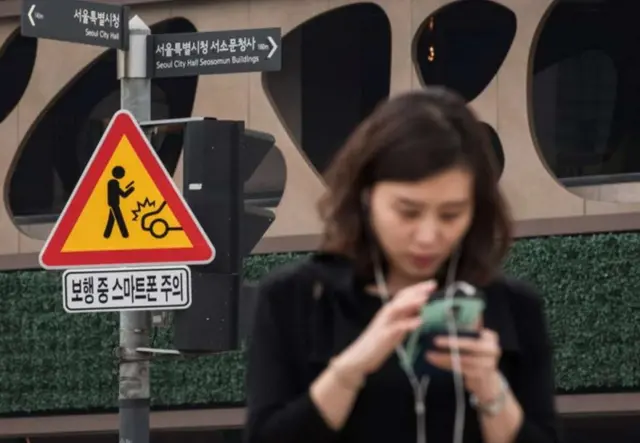Pedestrians glued to their smartphones were given something else to look at this week, as officials in Seoul launched a safety campaign to keep them from walking into busy traffic.
Smartphone-related collisions between pedestrians and vehicles in South Korea have more than doubled in five years to around 1,000 reported incidents in 2014, according to the Transportation Safety Authority.
The problem is especially acute in a country where smartphone penetration currently stands at around 80 per cent of the population, most of whom seem intent on mastering the art of walking and texting.
Some signs are attached to traffic light poles and depict a person looking at his smartphone as he is about to be hit by a car.
Are you addicted to your smartphone? You may need professional help...
But given that the target audience are people who would not look up from their screens to see such warnings, other signs have been plastered on the actual sidewalk.
“We put 250 signs on the pavements because they will actually be seen by the pedestrians that are looking down at their smartphones,” Kim said.
But neither type of warning seemed to have registered with locals interviewed at lunchtime.
“I am always on my smartphone, and I have never seen the signs before,” said Kim Hyun-chul, 29. “They need to make them stand out more.”
Koo Sung-hoi, 27, was also unaware of the efforts to keep him from a smartphone-related injury.
“I think the signs on the pavements are too small to be noticed,” Koo said.
South Korean smartphone users spend an average of four hours a day tweeting, chatting or playing games, with about 15 per cent showing symptoms of addiction, according to state data.
Seoul plans to monitor the effectiveness of the signs until the end of the year before deciding whether to expand the project.
The single cause of smartphone addiction
Similar campaigns have already been trialled in Europe. Antwerp has introduced designated walking lanes in a handful of busy shopping streets so smartphone users can look at their mobiles without bumping into other pedestrians. The German city of Augsburg even installed traffic lights in the pavement at tram crossings for smartphone gazers.
A 2014 simulation found that if 1,500 people looking at their phones tried to cross Tokyo’s notoriously crowded Shibuya intersection, only about a third would make across without bumping into others, falling or dropping their mobiles.
Korea leads the world in terms of the number of people who get their news on smartphones, though they mostly read sports news and celebrity gossip.
A survey of 26 countries by the Korea Press Foundation and the Reuters Institute for the Study of Journalism found that 48 percent of Koreans read news on their smartphones.
(APD)
 简体中文
简体中文

